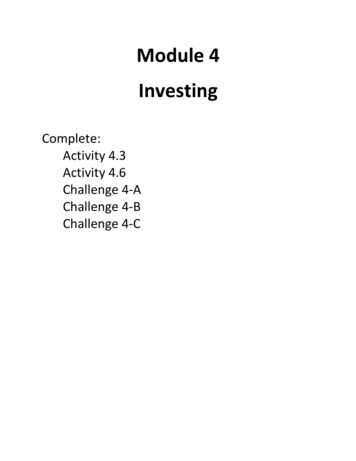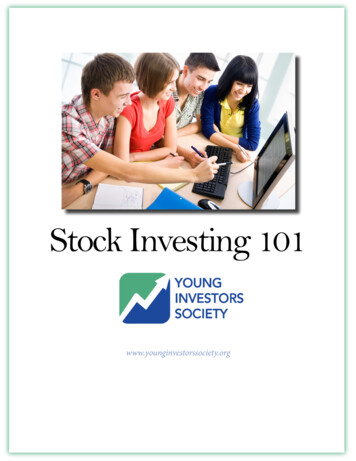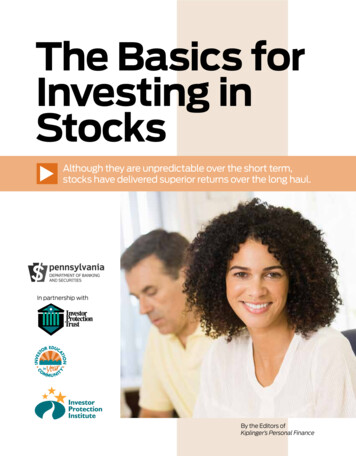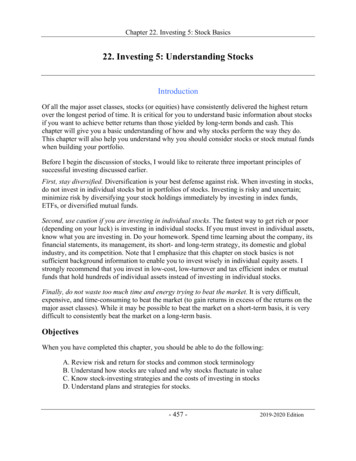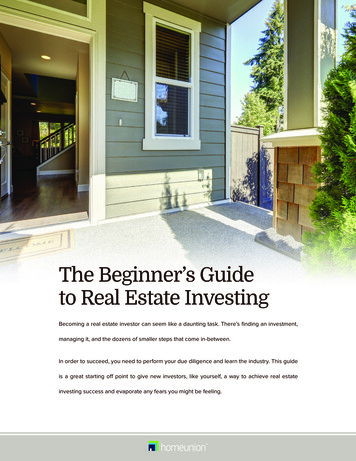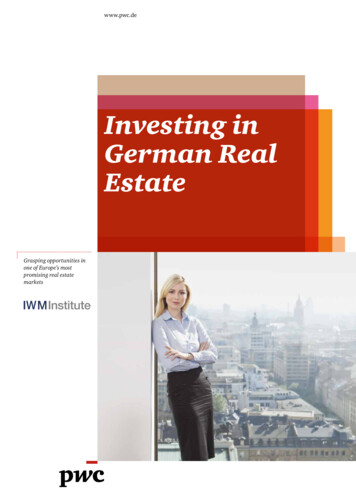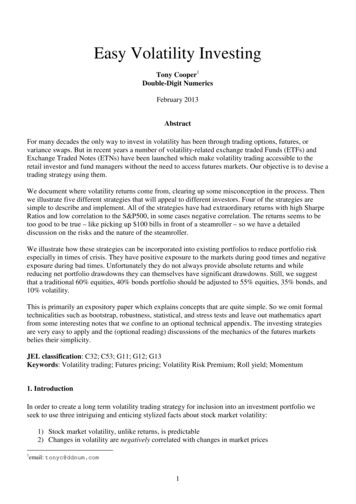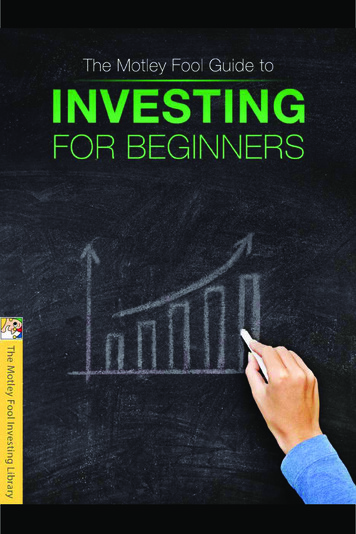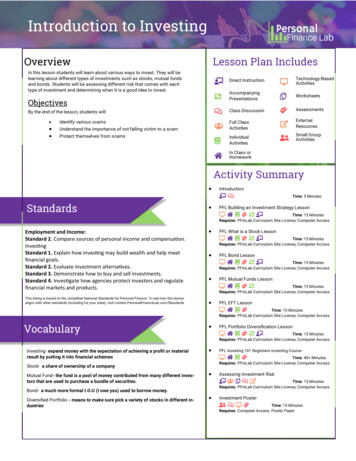
Transcription
Investing moduleTrainer’s introductionWhen people begin to save, they can put their money to work and to grow. They needto find investments that are suitable for their goals and finances, whether that means asimple deposit at their own financial institution, or more complex investments theydiscuss with a professional advisor. To decide their investing goals, speak to an advisorwith confidence and to avoid potential fraud, they need to know the basic language andconcepts of investing.This module describes how to get investment advice that is appropriate for the typicalsmall investor. Mini-module 1 has participants look at their own investing goals andneeds. Mini-module 2 outlines basic factors about investments, and mini-module 3describes various types of investments. Mini-module 4 covers how to work withinvesting professionals and Mini-module 5 highlights tips to keep your money safe frominvestment fraud.Learning objectivesAfter completing the module, learners will be able to: Explain the relationship between saving and investingExplain the objectives of investing and the benefits of choosing an appropriate form ofinvestment for their savingsList factors that affect their personal choice of an appropriate form of investment, suchas age, risk tolerance and investment objectivesState their own investment goals in general termsDescribe the relationship between the expected return and the risk of an investmentList factors to consider when choosing and talking to an investment adviserIdentify where to get information about various financial advisersIdentify appropriate sources of recourse if they are unsatisfied with their investmentadviserIdentify the types of fees and costs they can expect to pay for an investmentDescribe the impact of fees and costs on the return on an investmentDescribe the main types of investment (stocks, interest-paying, real and personalproperty, business) and their main features (risk, return and liquidity)Explain what mutual funds are and list their advantages and disadvantages for apersonal investor
Describe the advantages and disadvantages of real property (in a home or other asset)as a form of investmentExplain why diversification is important for an investorDescribe the main ways for a small investor to achieve diversificationRead and understand an investment account statement and identify any errors orproblemsIdentify Red Flags for investment fraud and ways to check out the legitimacy of aninvestmentMaterials/equipment required Copies of selected mini-modules or activities for participantsPowerPoint file: InvestingPowerPoint projector and screenInternet connection (if using)Time requiredIntroduction1: Investing goalsTo do all the activities in thismodule would requireapproximately: 10 minutes 45 minutesTo complete the module in onehour, focus on: 2: About investments3: Types of investments 35 minutes40 minutes 4: Investment advisors 50 minutes 5: Investment fraud7: Action plan 50 minutes5 minutes to get started Activity 1Slide 7Activity 3 (My investinggoals)Slides 15 to 19Activity 10 (Video:Registered Savings Plans)Activity 13 (Video:Choosing a FinancialProfessional)Slides 36 to 38Activity 19 (Action plan)Suggested activities and PowerPointsUse the slides together with the text in the online or printed modules. The text providesadditional information, items that are not easily represented in a slide, worksheets andother references.Select the slides you will need for your presentation. You will not need all the slides ifyou don’t plan to cover all the topics.
IntroductionCustomize the agenda as needed. Introduce the workshop topic and outline thecontents.Slide 1: Investing title pageInvestingSlide 2: AgendaAgendaStart time:Break time: (10 minutes)End time:Please set phones to silent ring and answer outside of the room.Acti vit y 1. IcebreakerHave participants complete the Investing Self-quiz in the Investing Goals booklet. Use Slide 3 tobriefly review the correct answers.Extend the discussion by asking questions such as the following: What do your results tell you about your own understanding of investing? If there’s one thing you want to learn in this session, what would it be? What’s the most important thing to know about investing as you manage your personalfinances? If there’s one thing you could already tell your best friend about investing as you manageyour money, what would it be?Conclude the activity by summarizing some things people already know. Explain that thesession is going to build on what people know to help participants invest to manage theirfinances more effectively.
Slide 3: Investing self-quizInvesting self-quizSlide 4: InvestingInvestingThis module covers: how to set appropriate investing goals the key characteristics of investments (their return, risk and liquidity) the main types of investments that you are likely to encounter how to work with an investment professional your rights and responsibilities when investing how to keep your money safe from investment scamsMini-module 1: Investing goalsSlide 5: Title slide: Investing goalsInvesting goals
OverviewSlide 6: Investing goalsThis section covers: personal values, emotions and behaviours that affect your investment choices your knowledge about investing your goals related to investingActi vit y 2. Investing self-quizRefer to the Icebreaker activity on the worksheet, Investing Self-quiz (or do the activity now).Prompt discussion by asking questions such as the following: How much do most Canadians know about investing?o Answer: Most know only the basics, even about investments they own, and areat risk of making expensive mistakes when they invest. How much do people need to know about investing?o Answer: They need to know what their own investing goals are and how thataffects the investments they choose; they need to know how to avoid the risk ofinvestment fraud; and they need to know how to get reliable advice aboutinvesting. If you got the right answer to all the questions, would you know enough about investing?o Answer: If you got all the right answers, it would show that you have a basicunderstanding of several key points, but a careful investor needs knowledgeabout many other topics, and needs to be aware of changes that could affect heror his investments.My financial goals and profileSlide 7: Investing goalsInvesting goals Investing goals guide you in choosing investing strategies that suit your needsDefine what you are saving for and the time frameSet a target amount and deadlineYou will have several different goals; e.g.:o Save to pay off 500 in debts by December 31o Save 5,000 for education by 2013o Save 150,000 for retirement by 2025Goals may conflict and change over time
Acti vit y 3. My investi ng goal sRefer participants to the worksheet, My investing goals, in the Investing goals booklet and havethem define at least one short-, mid- and long-term goal each. Explain that participants canresearch specific costs later, but the first step is just to state the goals.Ask some participants to share their goals and ensure that they are written in a way that is clearand well-defined.Prompt discussion by asking questions such as the following: Which goals are most important, the short-term, mid-term or long-term goals?o Answer: All can be important goals. Short-term goals may get the most attentionbecause they come up soon, but it’s important to pay attention to the mid- andlong-term goals also because you have to start working on them before theycome up. How many people think they can afford all their goals?o Answer: Very few people can afford all their goals, but writing them out helpsyou decide which are most important to start with and which to delete or save forlater. What can you do if your goals change or conflict with other ones?o Answer: Review your investing goals regularly to decide what’s most importantand what you can afford. Your goals will change as your life changes, and theinvestments you own may also have to change.Slide 8: Investing profileInvesting profile Know yourselfo When will you need to use your money?o Do you need regular income or will you sell to take a profit?o Can you be flexible about when you use your money?o How much risk are you comfortable with?Investor profile helps understand what investments best suit your needs
Acti vit y 4. What kind of investor am I?Refer participants to the worksheet, What kind of investor am I? in the Investing goals bookletand have them fill in their personal responses. Explain that the focus is on their personal profile,and later topics will go over investment details.Ask some participants to share their goals and ensure that they are written in a way that is clearand well-defined.Prompt discussion by asking questions such as the following: How does an understanding of your investing profile help you manage your finances?o Answer: It helps make sure that any investments you choose are suitable foryour needs in terms of the time frame, type of return and level of risk. When you have a variety of different goals, how does it affect your investing profile?o Answer: Each goal may have a separate profile, so it’s important to review themseparately and plan for each important goal. How can you choose investments that match all of your goals?o Answer: For simple goals, one or more simple investments may be all you need.For more complex needs, consult with a licensed, professional adviser.Slide 9: Risk toleranceRisk tolerance Higher returns mean higher risksHow comfortable are you if:o You can’t guarantee what your investments will make?o The value of your investments rises and falls?o You know your investment could lose some or all of its value?Your tolerance for risk is part of your profile
Acti vit y 5. My tol erance for riskRefer participants to the worksheet, My tolerance for risk, in the Investing goals booklet andhave them fill it in.Ask some participants to share their goals and ensure that they are written in a way that is clearand well-defined.Prompt discussion by asking questions such as the following: What are some examples of risk for an investor?o Answer: Investors can be exposed to many kinds of risk. One key risk is thatsome types of investment can lose some or all of their value. How can investors or their advisors use their understanding of the investor’s tolerancefor risk?o Answer: They can choose investment products that balance the level of risk withthe potential return to match the investor’s needs. How much should you rely on your risk tolerance?o Answer: Risk tolerance describes how comfortable you are with risk in yourinvestments, but you may be willing to tolerate a different level of risk for differentgoals, and different levels of risk at different times in your life.My financial choicesSlide 10: Saving, investing and debtSaving, investing and debt Save at least 10 percent of your pay if you canSave an emergency fundPaying off debts often provides the best returnConsider investing your savingsSlide 11: Personal values, emotions and behavioursPersonal Values, emotions and behaviours In addition to financial factors, be aware of your personal factors:o Emotionso Habitso Behaviourso ValuesThese can affect investing decisions, for better or worse.
Acti vit y 6. My habits, val ues, emotions and b ehavioursRefer participants to the worksheet, My habits, values, emotions and behaviours, in theInvesting goals booklet and have them fill it in.Ask some participants to share their goals and ensure that they are written in a way that is clearand well-defined.Prompt discussion by asking questions such as the following: Can you describe some ways that habits, values, emotions or behaviours have affectedyour own financial decisions or those of someone you know? How can investors or their advisors use their understanding of their own habits, values,emotions or behaviours?o Answer: They can become aware of the influences on their financial decisions,and try to emphasize the positive influences, and be aware of potential pitfalls ifthey don’t closely watch their own behaviour.Acti vit y 7. Summary of key messagesHave participants in pairs or small groups discuss and write down the three or four mostimportant things they learned during the session.Ask a few to compare their lists with the Summary of key messages (in the text or PowerPointslide).Clarify any misunderstandings and point out how the messages build on the topics participantsidentified in the first activity.Slide 12: Summary of key messagesSummary of key messages Understand the investing basicsSet clear investing goalsKnow yourself:o Understand your investor profileo Know your tolerance for risko Be aware of your emotions, habits, values and behavioursConsider paying off debt before investing
Mini-module 2: About investmentsSlide 13: Title slide: About investmentsAbout investmentsOverviewSlide 14: About investmentsThis section covers: the main characteristics of an investment:o returno risko liquidity the importance of diversification when choosing investmentsInvestment characteristicsSlide 15: ReturnReturnThe profit an investor makes on an investment Income—money you receive while you own the investmento Interest—money paid to you at a certain percentageo Dividends—part of a company’s profits paid to each shareholdero Rent—money you receive for the use of property Increased value—the profit from selling investments for more than you paido Capital gain (or capital loss)Slide 16: RiskRiskThe amount of uncertainty about what you’ll get on an investment Many kinds of risk:o Uncertainty about what the return will beo The chance you will lose some or all of the investmento The ability to judge the value of an investment
Slide 17: Risk vs. expected returnRisk vs. expected returnHigher expected return means higher risk and higher potential for lossesSlide 18: LiquidityLiquidityThe ability to cash in or sell an investment quickly at or near the current market price High liquidity: listed stocks, government bonds, etc. Lower liquidity: real estate, business property, etc. Low liquidity: term deposits, collectibles, etc.DiversificationSlide 19: DiversificationDiversificationGetting a mix of investments Don’t put all your eggs in one basket Diversify investments by:o choosing different types of investmentso choosing different companies or industrieso choosing investments in different geographical areas
Acti vit y 8. Which investor are you?Refer participants to the activity, Which investor are you? in the About investments booklet.Briefly review the asset mix examples using the slide below and then have participants draw anasset mix for their own needs.Ask some participants to share their asset mix and their reasons.Prompt discussion by asking questions such as the following: How does your asset mix fit your own life situation? Why does the proportion of high (speculative), moderate and low risk investmentschange with each investor?o Answer: Each is in a different life situation and has different financial needs, sothe types of investments and risks they have also changes. How can you adjust the risk in your overall investment portfolio?o Answer: Choose investments with more or less risk to balance out the level ofrisk you are comfortable with. When should you adjust the risk in your overall investment portfolio?o Answer: Whenever your life situation changes significantly, you should reviewwhether your asset mix still matches your goals. Everyone is likely to be a varietyof different investors simultaneously, depending on each of their different goals.Slide 20: Which investor are you?Which investor are you?Acti vit y 9. Summary of key messagesHave participants in pairs or small groups discuss and write down the three or four mostimportant things they learned during the session.Ask a few to compare their lists with the Summary of key messages (in the text or PowerPointslide).Clarify any misunderstandings and point out how the messages build on the topics participants
identified in the first activity.Slide 21: Summary of key messagesSummary of key messages Every investment can be described in terms of its return, risk and liquidityFor a high return, you must accept a higher riskYour tolerance for risk affects your investment choicesReduce risk with a diversified portfolioGet advice from a registered investment professionalMini-module 3: Types of investmentsSlide 22: Title slide: Types of investmentsTypes of investmentsOverviewSlide 23: Types of investmentsThis section covers: the main investments that a beginning investor will come across the effect of taxes when you are investing key questions to ask about an investmentSlide 24: Main types of investmentsMain types of investments Propertyo Real estate, personal property, business propertyInvestments that pay interesto Bonds, term deposits, GICs, T-billsStockso Common stocks, preferred stocksInvestment fundso Mutual funds, exchange traded funds, etc.
TIP:Point out that the About investments booklet has a list of the most common investmentsand their basic characteristics.Registered plansActi vit y 10. Video: Investing w ith Registered Savi ngs PlansIntroduce the video and give participants a copy of the video response sheet. Have themanswer the questions on the sheet as they view the video and when it ends.Following the video, ask some participants to share their comments with a neighbour or with thegroup.Extend the discussion by asking questions such as the following: Why are registered savings plans often a good investment?o Answer: They can provide tax benefits that can increase the value of theinvestment return. Deferring taxes provides a financial benefit, especially if youcan re-invest a tax refund. Some plans, such as RESPs, provide additional gainsthrough government grants. Who can benefit from registered plans?o Answer: Most people can benefit from TFSAs and RRSPs. RESPs benefitpeople saving for a child’s education, and RDSPs benefit people who want tosupport someone with a disability. How can you make sure you get registered investments that suit your investing goals?o Answer: Discuss your goals with your adviser, and ask questions to be sure youunderstand how a registered plan will help you reach your goals.Video response sheetName: Date:Name of video:What points in the video do you agree with?What points in the video do you disagree with?What points in the video do you need more information about?
If you had to summarize the video for a friend, what would you say were the most importantpoints?Choosing investmentsActi vit y 11. Video: How to Choose InvestmentsIntroduce the video and give participants a copy of the video response sheet. Have themanswer the questions on the sheet as they view the video and when it ends.Following the video, ask some participants to share their comments with a neighbour or with thegroup.Extend the discussion by asking questions such as the following: Can anyone describe a time when they or someone they knew felt they did not have theinformation they needed about an investment, and how it affected the investingoutcomes? What can you do if you feel you don’t have the information you need?o Answer: Ask questions and don’t invest until you have the answers you need. What is the best place to look for information about an investment?o Answer: A licensed investment adviser can often provide objective advice.Companies that offer investments to the public are also required to providecertain information about their business. Corporate information about aninvestment may be available at the SEDAR website (sedar.com). Informationfrom unknown or unverified sources is often unreliable.Point out that the About Investments booklet has a list of questions to ask about an investment,which can help you evaluate whether an in
small investor. Mini-module 1 has participants look at their own investing goals and needs. Mini-module 2 outlines basic factors about investments, and mini-module 3 describes various types of investments. Mini-module 4 covers how to work with investing professionals and Mini-module 5 highl
